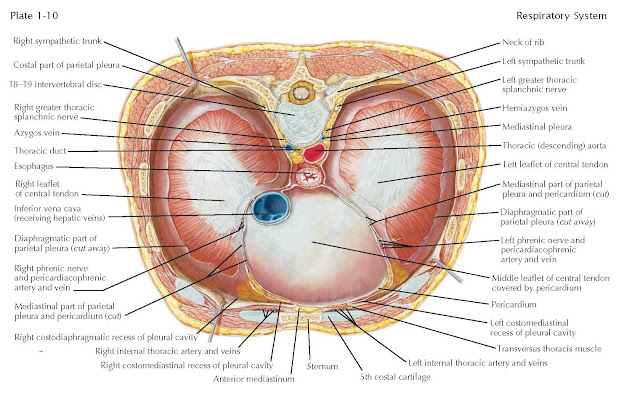Diaphragm (Viewed From Above)
The diaphragm is a curved
musculotendinous septum separating the thoracic from the abdominal cavity,
forming the floor of the thoracic cavity with its convex upper surface facing the
thorax. The dome of the diaphragm on the right side is as high as the fifth
costal cartilage (varying with the phase of respiration) and on the left is
only slightly lower, so that some of the abdominal viscera are covered by the
thoracic cage.
The origin of the diaphragm is from the outlet of the thorax and has
three parts: sternal, costal, and lumbar.
The sternal origin is by two fleshy slips from the back of the
xiphoid process. The costal origin is by fleshy slips that interdigitate
with the slips of origin of the trans- versus abdominis muscle and arise from
the inner surfaces of the costal cartilages and adjacent parts of the last six
ribs on each side. The lumbar portion of the origin is by a right and a
left crus and right and left medial and lateral lumbocostal arches (sometimes
termed arcuate ligaments). The tendinous crura blend with the anterior
longitudinal ligament of the vertebral column and are attached to the anterior
surfaces of the lumbar vertebral
bodies and related intervertebral discs to the first three on the right and the
first two on the left. The medial lumbocostal arch, a thickening of the fascia
covering the psoas major muscle, extends from the side of the body of the first
or second lumbar vertebra to the front of the transverse process of the first
(sometimes also the second) lumbar vertebra. The lateral lumbocostal arch,
passing across the quadratus lumborum muscle, extends from the transverse
process of the first lumbar vertebra to the tip and lower border of the twelfth
rib.
From the extensive origin just described, the fibers converge to insert in
a three-leafed central tendon. Contraction of the muscular portion of the
diaphragm pulls the central tendon downward, thus increasing the volume of the
thoracic cavity and bringing about inspiration.
The diaphragmatic nerve supply is by way of the right and left phrenic
nerves, which are branches of the right and left cervical plexuses and receive
their fibers primarily from the fourth cervical nerves, with some contribution
from the third and fifth cervical nerves.
Several structures pass between the thoracic and abdominal cavities,
mainly through apertures in the diaphragm.
The aortic aperture is at the level of the twelfth thoracic
vertebra situated between the diaphragm and the vertebra. It transmits the aorta, azygos vein, and thoracic duct.
The esophageal aperture is located at the level of the tenth
thoracic vertebra in the fleshy part of the diaphragm. It transmits the
esophagus, the right and left vagus nerves, and small esophageal arteries and
veins.
The inferior vena caval aperture is situated at the level of the
disc between the eighth and ninth thoracic vertebrae at the junction of the
right and middle leaflets of the central tendon. It is traversed by the inferior
vena cava and some branches of the right phrenic nerve.
The right crus is pierced by the right greater and lesser splanchnic
nerves, and the left crus is pierced by the left greater and lesser splanchnic
nerves and the hemiazygos vein. The sympathetic trunks usually do not pierce
the diaphragm but pass behind the medial lumbocostal arches.
The base of the fibrous pericardial sac is partially blended with the
middle leaflet of the central tendon of the diaphragm. The diaphragmatic
portions of the parietal pleura are closely blended with the upper sur- faces
of the right and left portions of the diaphragm. Where the diaphragmatic pleura
reflects at a sharp angle to become the costal pleura, the costodiaphragmatic
recess or costophrenic sulcus is formed. Where the costal pleura reflects to
become pericardial pleura, the
costomediastinal recess is formed.





